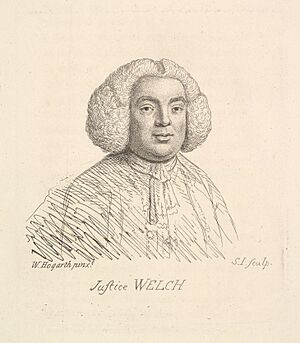Saunders Welch facts for kids
Saunders Welch (born February 2, 1711 – died October 1, 1784) was an important English businessman in the 1700s. He was also a justice of the peace for Middlesex, which meant he helped keep law and order. He is known for being a pioneer in policing.
Contents
Life and Early Years
Saunders Welch was born in Aylesbury. He went to school at the town's workhouse, a place where poor people could live and work. When he was young, he learned the trade of a trunk-maker in St Paul's Churchyard in London. Other stories say he received money from his family and was a true gentleman.
By 1734, he lived on Broad St Giles and ran a grocery store from his home. Around 1739, he moved to a bigger house on Bow Street. He started meeting artists and writers. Some say he even modeled for a famous statue of the composer George Frederick Handel.
Helping the Community
Saunders Welch cared a lot about his community. From 1740 onwards, he supported many religious, artistic, and literary projects. He also became involved with several important hospitals. These included the British Lying-In Hospital, the Lock Hospital, the Foundling Hospital, the Magdalen Hospital, the Middlesex Hospital, and St George's Hospital. These hospitals helped people who were sick or in need.
Involvement in Local Government
Welch also became active in local government. He was a churchwarden in 1743, helping manage the church. In 1745, he became a vestryman, which meant he was part of the local council. From 1746 to 1755, he served as the high constable of Holborn, a kind of chief police officer.
In 1755, he joined the Middlesex commission of the peace. This group included people who acted as judges for minor crimes. In these roles, he often worked with two brothers, Henry Fielding and John Fielding. They shared an office at Bow Street Magistrates' Court. Welch chose his police officers from former constables. These men were ready to get legal training and continue their work.
Later Life and Legacy
After Henry Fielding died, Welch and John Fielding had a disagreement. Welch left the Bow Street office. From the 1760s, he worked at a new "rotation office" on Litchfield Street. His friend, the famous writer Samuel Johnson, often visited him there.
Trying to make this new office pay for itself made Welch's health worse. The office struggled by 1775. Welch spent a few years in Italy to improve his health. He finally died in Taunton Deane, Somerset, in 1784. His body was brought back to St George's Gardens in Bloomsbury for burial.
Saunders Welch's Writings
In 1754, Saunders Welch published a book called An essay on the office of constable. This book gave rules and advice for constables to do their job safely and effectively. Four years later, he released an updated version. This new edition included ideas about where the constable's job came from in England. It also shared stories about "Thief-Takers" and why they caused problems. Thief-Takers were people who were paid to catch criminals.


